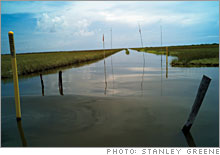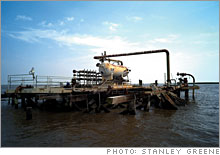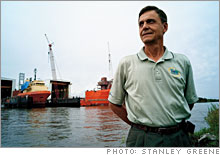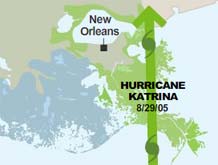The next energy crisisMore than a quarter of America's oil flows through southern Louisiana. Too bad the land is slowly sinking into the sea.Fortune Magazine -- Port Fourchon feels like the edge of the world. As you drive south on Louisiana Highway 1 through Bayou Lafourche, open marshes seem to stretch endlessly until you reach this spot, 60 miles below New Orleans. There, the marsh once known as trembling prairie meets the Gulf of Mexico. This is an oil-services installation. And though its existence is unknown to most Americans, it is vital to them. Without Port Fourchon and its fleet of vessels bringing food, supplies, equipment, and reinforcements to platforms in the gulf, the U.S. would lose access to nearly a fifth of all the oil and gas it uses.    Port Fourchon is also home to pipelines, miles and miles of them. There are the feeders from the Louisiana Offshore Oil Port, which accommodates the massive tankers that deliver 11 percent of the nation's foreign oil. There are conduits that supply two of the nation's strategic petroleum-reserve facilities. There are countless more for companies such as Shell (Charts), Chevron (Charts, Fortune 500), and BP (Charts). All told, the pipelines at Fourchon connect to half of the refining capacity in this country. And they're a key stem in a broader branching of pipelines in southern Louisiana, which combine to transport 27 percent of America's oil and 30 percent of its natural gas. If the port seems like a mirage on the edge of the marsh, that may be because its permanence is anything but assured. The port sits in a region that, although it escaped the most cataclysmic destruction of Katrina and Rita, is being ravaged by two slow-moving but equally ruinous phenomena: erosion and the sinking of the land. Some 25 square miles of Louisiana have been collapsing into the gulf each year for three-quarters of a century. A total of 1,900 square miles, roughly the area of Delaware, disappeared between the 1930s and 2005, and another 217 square miles were pulverized into liquid by Katrina and Rita. And that land loss, says Ted Falgout, who has run Port Fourchon for 28 years, poses a growing threat not only to the people who live here but also to the U.S. energy supply. "We're on a train wreck here," says Falgout. "We have not designed the energy infrastructure - or any infrastructure - [to handle land loss]." The problem afflicts all of southern Louisiana. As land turns to water, it is exposing thousands of miles of oil and gas pipelines that were built underground and were not designed to withstand water or waves. "There are places where a pipeline that was laid in marsh, well protected, is now in five or six feet of water - in an open bay that is subject to a vessel coming across and hitting it," says Falgout. "That's the thing that [oil companies] are spending their money on right now. It's so huge that they're just putting out fires." Most energy and pipeline companies seem loath to discuss the issue, but there are signs of anxiety. "The pipeline companies are very - I don't want to say nervous - they're very concerned," says Clifford Smith, chairman of T. Baker Smith, an engineering firm that has been designing and servicing pipelines in Louisiana since 1913. "We're constantly doing what we call as-builts" - inspections of existing pipelines - "and remedial work," he says. "Accidents are happening because of the changes in topography. It's a big thing." One of the few oil companies willing to talk describes land loss as a chronic challenge, but not an imminent crisis. "It's a real concern," says Melody Meyer, a vice president who heads Chevron's Gulf of Mexico operations. "But we've always been able to manage it." At least one oil executive views the threat in more dire terms. In 2004, Ed Landgraf, environmental coordinator for Shell Pipeline, sounded the alarm in congressional testimony. He characterized the destruction of land as "alarming" and called it a "national problem with serious national implications." As he put it, "Much of [southern Louisiana's] infrastructure is at risk as the coastline continues to disappear." His conclusion: "National energy security can be maintained only if Louisiana's coast is restored and preserved." Landgraf uttered those words a year before Katrina. Since then, the risk has increased "exponentially," according to Robert Twilley, a professor of coastal science who heads Louisiana State University's Gulf Restoration Initiative. Rita and Katrina knocked out gulf platforms and refineries and sent gasoline prices soaring, but the land-based pipelines largely survived. Now, though, Twilley says the ongoing loss of terrain means there will be even less margin of safety - for New Orleans, for southern Louisiana, and for the pipelines - the next time a hurricane blows through. The good news, if you can call it that, is that the destruction wrought by Katrina has raised awareness of coastal erosion. Louisianans understand that the very marshes that are being destroyed help shield them from hurricanes. But it's not clear if the message has penetrated Washington. And that raises the inevitable question: Will it take another Katrina to impel a major effort to protect the Louisiana coast? One man takes on the gulf Ted Falgout might appear to be an unlikely candidate to run an oil support facility: He was trained as a fisheries biologist. But in Louisiana that isn't such a strange mixture. Now 56, he grew up on Bayou Lafourche, where his family has lived since the Acadians - better known as Cajuns - settled there in the 1800s. His father was a fisherman, a trapper, and an oilfield worker. Like his dad, Falgout has kept a foot in both worlds: In addition to running the port, he co-owns an alligator farm. Port Fourchon has enjoyed huge success under Falgout's leadership. His operation, a state commission, consists of 1,200 acres rented to a wide variety of companies that service rigs and platforms in the gulf. The port has helicopter pads and an airport, and each plot comes with access to a slip so that each tenant's boat can make their way into the gulf. When Falgout started, the port had two tenants. Now it has more than 250, including oil majors such as BP, Chevron, ConocoPhillips (Charts, Fortune 500), and Shell and giant services companies such as Schlumberger (Charts), Baker Hughes (Charts, Fortune 500), and Halliburton (Charts, Fortune 500). Meanwhile, Falgout has spent years trying to raise awareness of land loss, repeatedly testifying before Congress about the threat to Louisiana's coast. As he does that, he has been preparing for the day, perhaps only ten years away, when his facility is no longer on the mainland. "We can sustain Port Fourchon as an island on the edge of the Gulf of Mexico," he says. More than a decade ago Falgout sank barges filled with rocks off Fourchon's south coast to temper erosion and storm surges. Now he's building a forested ridge on the north of the port to protect it from surges there. And he's been leading a campaign to raise Highway 1, which accommodates about 1,200 trucks a day, onto stilts so that it can operate even when the land on which it now sits ceases to exist. Oil companies, too, are grappling with the coastal forces, though it's hard to discern because pipelines are mostly out of sight under the bayou muck. As I'm skippered in a boat up and down Fourchon's bayous on a sweltering July day, the most common evidence of the infrastructure are signs that dot the edge of the water: warning: do not anchor or dredge. oil pipeline. But inside a bayou called Belle Pass, you can see one oil company tackling an erosion problem. A Chevron barge with two cranes on it floats there, in the process of replacing 11 miles of pipe. On the barge, workers are welding sections of ten-inch pipe that will be lowered into the water. Later, water jets will force it down into a 48-inch-deep trench, after which it will be covered with the mud. The new pipe is a replacement for a 1960s-vintage predecessor, says Becky Roberts, president of Chevron Pipeline, which owns or operates 2,500 miles of pipelines in southern Louisiana. The old pipe "had become exposed over time," she says. "We knew we needed to do something different. And we chose to take on more expense and move that line to an area that would cause the least disruption [to the coast] and would give the most protection for the pipeline in the future." The replacement process is laborious, made even more so on the previous day when company workers stumbled across two non-Chevron pipelines that weren't marked on their maps. "I'm going to treat them as if they're hot [until proven otherwise]," explains Joe Adams, a contract engineer on the barge. (By "hot" he means full of oil or gas.) So work stops, and the Chevron team has to wait for surveyors to see whether the pipelines are actually transporting something - and if so, who owns them. "It's going to be a spaghetti factory out there," says Adams of the tangle of pipelines he expects to encounter. "Spaghetti bowl" is a phrase often used to describe the energy infrastructure in, variously, southern Louisiana, the gulf, and Texas. The system is a gigantic jumble that evolved without much overall planning. Some oil companies meticulously mapped as they built; others didn't. As a result, says John Snead of the Louisiana Geological Survey, "nobody knows exactly how many pipelines there are in any part of the state." His best estimate is 14,000 miles of "transmission lines" in Louisiana. That leaves out, for example, small "flow lines" - say, a four-inch pipe running from an individual oil well to a collection facility. In recent years the state of Louisiana has embarked on the grueling process of improving its infrastructure maps. People trudge through marshes looking for so-called witness posts, aboveground markers for pipelines. After one such study, notes Roland Guidry, Louisiana's oil-spill coordinator, "some of the companies were flabbergasted that their pipelines were over a quarter of a mile off from where they thought." Oil lines and the environment Louisiana's pipelines may not always be easy to locate, but their environmental impact is well understood. Along with levees and shipping channels, the pipelines - or rather the canals dug to lay them in the marsh - cause erosion and land loss. In its natural condition the Mississippi River fed the terrain along its banks with regular floods that replenished the land's sediment. But after hundreds of years of levee building on the river, its sustaining silt pours out into the bottom of the Gulf of Mexico. In effect, the land in southern Louisiana has been starved and is slowly sinking, even as sea levels rise because of climate change. Meanwhile, endless channels and canals have been carved out of the marshes for shipping and for oil and gas wells and facilities. Those canals eat away at the marshes and allow damaging incursions of salt water, which can kill freshwater vegetation. "All this was marsh when I was a kid," says Allen Moreau, 41. "My grandaddy could walk across it." Moreau, who runs a charter fishing boat, is piloting up a bayou in Venice, La., on another 95-degree July day. The area he is describing as formerly solid land is open water. Also on the boat is George Pivach, general counsel for the Venice Port Complex, a smaller version of Port Fourchon in Plaquemines Parish. As we float further south, Pivach points to two parallel rows of rocks extending several hundred feet. He explains that they marked where one of the bayous joined the gulf. Two decades later the bayou is gone, and the lines are stranded a mile out in the gulf like a landing strip in an aqueous desert. Every so often Pivach calls my attention to a "well jacket," a protective apparatus for an oil well. The wells, he says, were constructed on solid land, but now they are their own little islands. The flow lines that take oil from the wells to bigger collection facilities periodically poke out of the water. They were originally built underground, Pivach explains, so the oil companies didn't erect signs to warn passing boats of the protruding pipes. Since Katrina, awareness of land loss has crested and created a sense of purpose in Louisiana. The state legislature this spring passed a master plan to restore the coast. And after Governor Kathleen Blanco sued the U.S. Department of the Interior last year, the federal government agreed, for the first time, to give the state 38 percent of the royalties it collects for oil drilling in newly developed areas of the gulf. That may amount to $500 million a year. There's still a long way to go. The state plan will cost an estimated $50 billion over 30 to 40 years. That $500 million in annual royalties could go a long way to funding it, but the money won't fully kick in for another decade. The biggest aid would come from new federal funding, and so far not much is happening there. Even if Washington does come through with serious funding, many Louisianans fear that the lion's share will go to the levees - some of which, as noted, are part of the problem. Mississippi river levees, shipping channels, and oil and gas canals cause land loss. So how do you reverse that loss unless you plan to get rid of some levees - which would expose people to floods - or close down shipping channels or oil canals? The state's master plan shows a laudable willingness to make some of those brutal choices, but many Louisianans wonder whether the feds will go that far. "This is a life-or-death situation, okay?" says Sidney Coffee, Blanco's chief advisor on coastal issues and chair of the Louisiana Coastal Protection and Restoration Authority. "We're beyond urgent down here in what we're dealing with," she says, "and we'll never get from here to there if we keep the same process that we have right now, the same federal process." You can detect a strain of resentment in Louisiana these days. The refrain goes like this: We sacrificed our environment to give the country oil - and now the country doesn't want to help us protect the land that allows it to flow. Not everyone buys this increasingly common interpretation of events. (Skeptics recall the decades in which 50 percent of the state's tax revenues came from oil companies. As longtime environmentalist and Tulane law professor Oliver Houck wrote last year, "Today we tell Congress that we 'sacrificed' ourselves for the national good. Never has there been such a willing, complicit sacrifice. We made a bundle of money, wasted most of it, and blackballed anyone who questioned what it was doing to the Louisiana coast.") But it's clear that others are not going to volunteer to replace Louisiana. "The last time I checked," says Falgout, "there was nobody waiting in line to take Louisiana's place in servicing the energy industry. Okay? Certainly not California and Florida. The environmental impacts to moving somewhere else would be huge. And in this country, it just ain't going to happen." It will be hard to restore the coast without industry support. Most oil companies say they endorse coastal restoration; many even write checks to America's Wetlands, a foundation that is raising awareness of the issue. But the companies have not taken a public role in, say, lobbying Congress. (For now, the prevailing industry view is to address the issue pipeline by pipeline. As Chevron's Roberts puts it, "We're used to operating in difficult environments.") Once you have the energy people actively involved, then you have to bring in the shipping and fishing industries, the developers, and, not least, the whole morass of various government entities. It's a daunting challenge, notes Mark Davis, a thoughtful senior research fellow at Tulane who used to run the Coalition to Restore Coastal Louisiana. But for all the obstacles, Davis has some hope: The country has taken on daunting challenges before, he says - the Interstate Highway System and even past projects on the Mississippi. "The scale of action we're talking about is not unprecedented," he says. "But it took a sense of national purpose. Not federal purpose. That's the key thing here. That's why people should care about what happens here. It's not because you have to love Cajun food or you love pulling some oil company's fat out of the fire. It's because, quite frankly, the country has a lot at stake here." Video: Photojournalist Stanley Greene and Fortune senior writer Adam Lashinsky document the progress in New Orleans. Where's the relief money? Billions have been spent to rebuild New Orleans. But not enough is reaching the local economy. Here's why. |
Sponsors
|

